
Heating, ventilation, and air conditioning (HVAC) is the use of various technologies to control the temperature, humidity, and purity of the air in an enclosed space. Its goal is to provide thermal comfort and acceptable indoor air quality. HVAC system design is a subdiscipline of mechanical engineering, based on the principles of thermodynamics, fluid mechanics, and heat transfer. "Refrigeration" is sometimes added to the field's abbreviation as HVAC&R or HVACR, or "ventilation" is dropped, as in HACR.
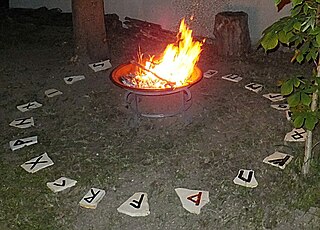
A brazier is a container used to burn charcoal or other solid fuel for cooking, heating or cultural rituals. It often takes the form of a metal box or bowl with feet. Its elevation helps circulate air, feeding oxygen to the fire. Braziers have been used since ancient times; the Nimrud brazier dates to at least 824 BC.

Dry distillation is the heating of solid materials to produce gaseous products. The method may involve pyrolysis or thermolysis, or it may not.
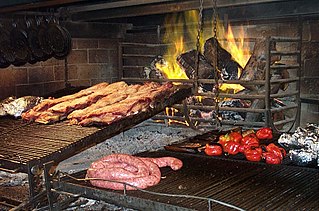
Asado is the technique and the social event of having or attending a barbecue in various South American countries, especially Argentina, Chile, Paraguay, Peru and Uruguay where it is also a traditional event. An asado usually consists of beef, pork, chicken, chorizo, and morcilla, all of which are cooked using an open fire or a grill, called a parrilla. Usually, red wine and side dishes such as salads accompany the main meats, which are prepared by a designated cook called the asador or parrillero.
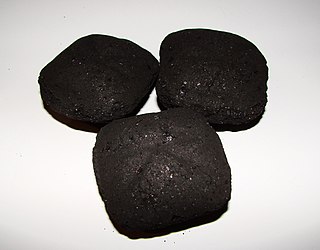
A briquette is a compressed block of coal dust or other combustible biomass material used for fuel and kindling to start a fire. The term derives from the French word brique, meaning brick.
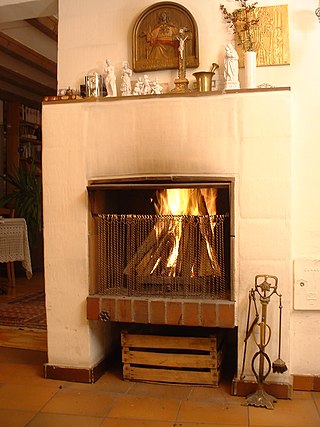
A fireplace or hearth is a structure made of brick, stone or metal designed to contain a fire. Fireplaces are used for the relaxing ambiance they create and for heating a room. Modern fireplaces vary in heat efficiency, depending on the design.

Carburizing, or carburising, is a heat treatment process in which iron or steel absorbs carbon while the metal is heated in the presence of a carbon-bearing material, such as charcoal or carbon monoxide. The intent is to make the metal harder and more wear resistant. Depending on the amount of time and temperature, the affected area can vary in carbon content. Longer carburizing times and higher temperatures typically increase the depth of carbon diffusion. When the iron or steel is cooled rapidly by quenching, the higher carbon content on the outer surface becomes hard due to the transformation from austenite to martensite, while the core remains soft and tough as a ferritic and/or pearlite microstructure.

Ondol or gudeul in Korean traditional architecture is underfloor heating that uses direct heat transfer from wood smoke to heat the underside of a thick masonry floor. In modern usage it refers to any type of underfloor heating, or to a hotel or a sleeping room in Korean style.

A kotatsu is a low, wooden table frame covered by a futon, or heavy blanket, upon which a table top sits. Underneath is a heat source, formerly a charcoal brazier but now electric, often built into the table itself. Kotatsu are used almost exclusively in Japan, although similar devices for the same purpose of heating are used elsewhere, e.g. the Spanish brasero or Iranian korsi.

The hibachi is a traditional Japanese heating device. It is a brazier which is a round, cylindrical, or box-shaped, open-topped container, made from or lined with a heatproof material and designed to hold burning charcoal. It is believed hibachi date back to the Heian period. It is filled with incombustible ash, and charcoal sits in the center of the ash. To handle the charcoal, a pair of metal chopsticks called hibashi is used, in a way similar to Western fire irons or tongs. Hibachi were used for heating, not for cooking. It heats by radiation, and is too weak to warm a whole room. Sometimes, people placed a tetsubin over the hibachi to boil water for tea. Later, by the 1900s, some cooking was also done over the hibachi.

A bloomery is a type of metallurgical furnace once used widely for smelting iron from its oxides. The bloomery was the earliest form of smelter capable of smelting iron. Bloomeries produce a porous mass of iron and slag called a bloom. The mix of slag and iron in the bloom, termed sponge iron, is usually consolidated and further forged into wrought iron. Blast furnaces, which produce pig iron, have largely superseded bloomeries.

A fan heater, also called a blow heater, is a heater that works by using a fan to pass air over a heat source. This heats up the air, which then leaves the heater, warming up the surrounding room. They can heat an enclosed space such as a room faster than a heater without a fan, but like any fan, create a degree of noise.
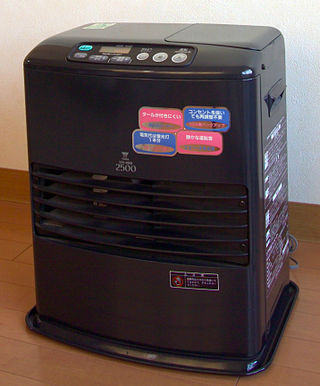
A kerosene heater, also known as a paraffin heater, is typically a portable, unvented, kerosene-fueled, space heating device. In Japan and other countries, they are a primary source of home heat. In the United States and Australia, they are a supplemental heat or a source of emergency heat during a power outage. Most kerosene heaters produce between 3.3 and 6.8 kilowatts.
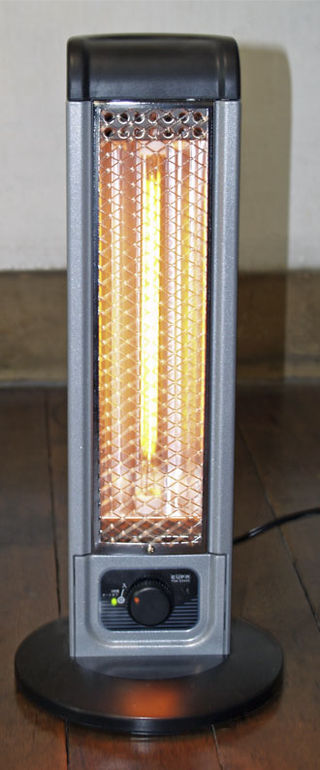
A space heater is a device used to heat a single, small- to medium-sized area. This type of heater can be contrasted with central heating, which distributes heat to multiple areas.

An infrared heater or heat lamp is a heating appliance containing a high-temperature emitter that transfers energy to a cooler object through electromagnetic radiation. Depending on the temperature of the emitter, the wavelength of the peak of the infrared radiation ranges from 750 nm to 1 mm. No contact or medium between the emitter and cool object is needed for the energy transfer. Infrared heaters can be operated in vacuum or atmosphere.

Brasero is a free and open-source disc-burning program for Unix-like operating systems, it serves as a graphical front-end to cdrtools, cdrskin, growisofs, and (optionally) libburn. Licensed under the terms of the GNU General Public License.

Charcoal is a lightweight black carbon residue produced by strongly heating wood in minimal oxygen to remove all water and volatile constituents. In the traditional version of this pyrolysis process, called charcoal burning, often by forming a charcoal kiln, the heat is supplied by burning part of the starting material itself, with a limited supply of oxygen. The material can also be heated in a closed retort. Modern "charcoal" briquettes used for outdoor cooking may contain many other additives, e.g. coal.

A bukhāri is a traditional space heater from Central Asia and northern areas of the Indian Subcontinent, which is typically a wood-burning stove. Bukharis consist of a wide cylindrical fire-chamber at the base in which wood, charcoal or other fuel is burned and a narrower cylinder on the top that helps in heating the room and acts as a chimney. The base of an Indian bukhari is wider than that of most western wood-burning stoves. Bukharis are found in the entire northern belt of the region, i.e. Afghanistan, Tajikistan, northern Pakistan, North India, Nepal, Bhutan and Northeast India.
An angithi is a traditional brazier used for space-heating and cooking in the northern areas of South Asia, mainly in India, Pakistan and Nepal. Angithis usually generate heat from burning coal and, when in use, have glowing coal or charcoal pieces but few or no flames.
A catalytic heater is a flameless heater which relies on catalyzed chemical reactions to break down molecules and produce califaction (heat). When the catalyst, fuel, and oxygen combine together, they react at a low enough temperature that a flame is not produced. This process keeps repeating itself until either oxygen or the fuel source is taken out of the equation.
















